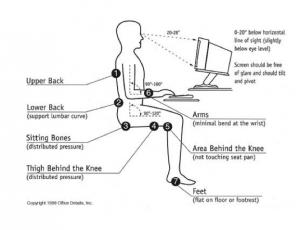Doctors’ Notes
BackComputer Ergonomics
Whether it’s for homework, gaming, or just chatting with their friends, kids are spending more and more time at a computer, so it’s important to make sure they’re sitting correctly. I know “sitting correctly” sounds crazy, but if a child spends countless hours sitting at a computer the wrong way, he or she can develop some bad habits that can lead to orthopedic issues.
Here are some general rules of thumb to keep your kids safe.
FEET PLACEMENT
Keep both feet on the floor, with the knees at a 90 degree angle. This will distribute weight better through the rest of the body. Especially at home, when multiple people are using the computer, try to invest in an adjustable chair to accommodate everyone in the family.
SIT UP STRAIGHT
(I sound like my parents here!) Educate your children to sit with their rear end in the back of the chair and feet on the floor. This will allow the child to have upright posture more easily.
ARM PLACEMENT
Forearms should be parallel to the floor, with the elbow at 90-100 degrees. Some computer chairs have adjustable arm rests to accommodate for everyone in the family.
UPPER BACK
Instead of leaning into the computer or tilting far away, the shoulder blades should be resting on the back of the chair.
EYE SIGHT
Eyes should be parallel with the top of the computer screen to decrease the chance for straining the neck. Also, rest the eyes. A general rule of thumb is 20-20: stare at a blank wall 20 feet away for 20 seconds. This will help decrease eye strain and headaches.
BREAK TIME
Encourage mandatory breaks from the computer every 20-30 minutes if allowed. Setting a timer or phone to sound every 20-30 minutes can help remind them to stop for a few minutes.
STRETCH
Stretch and move while working on the computer — with head rolls, shoulder rolls, or marching in place while seated, to decrease pressure on different parts of the body.
If your child starts to exhibit signs of fatigue, headaches, or cramping in the neck, back, shoulders or forearms, intervene early to prevent these issues from developing.
Dan Schaus is a physical therapist with Oakmont Orthopaedic and Sports Physical Therapy Center.
